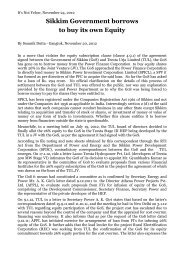Socio-Cultural Environment - Affected Citizens of Teesta (ACT)
Socio-Cultural Environment - Affected Citizens of Teesta (ACT)
Socio-Cultural Environment - Affected Citizens of Teesta (ACT)
Create successful ePaper yourself
Turn your PDF publications into a flip-book with our unique Google optimized e-Paper software.
Bahuns, Chhetris, Thakuris, almost all the service castes, most <strong>of</strong> the<br />
Newars, Rais, Gurungs and even Tsongs pr<strong>of</strong>ess Hinduism.<br />
A section <strong>of</strong> Lepchas, Rais and some <strong>of</strong> the Nepalese castes <strong>of</strong><br />
the district have adopted Christianity. For obvious political reasons,<br />
Christianity could not proliferate much during the reign <strong>of</strong> Bhutia rulers,<br />
yet some <strong>of</strong> the Sikkimese including a few Bhutias became Christians<br />
under the influence <strong>of</strong> Missionary school education they received from<br />
outside the state. South district has the unique distinction <strong>of</strong> having a<br />
village where majority <strong>of</strong> the people are Christians. The Lepcha village<br />
<strong>of</strong> Wak in Namchi subdivision is a Christian enclave surrounded by<br />
predominantly Buddhist (Bhutia) and Hindu (Nepalese) communities.<br />
Bon is a religion that was prevalent in Tibet before the advent <strong>of</strong><br />
Buddhism. A few <strong>of</strong> the early settlers in Sikkim are still found to practice<br />
Bon religion. They have their lone monastery at Kewzing. Though the<br />
number <strong>of</strong> Bon followers is not much, they preserved a very old<br />
traditional form <strong>of</strong> religion.<br />
The indigenous Lepchas and Limbus, in spite <strong>of</strong> their allegiance<br />
to the greater traditions <strong>of</strong> Buddhism and Hinduism, still follow the little<br />
traditions <strong>of</strong> nature worship. The religious festivals <strong>of</strong> these two<br />
communities are usually based on obeisance paid to supernatural<br />
powers that they perceive to be associated with certain objects <strong>of</strong><br />
nature. Both the communities practice Shamanism (Practice <strong>of</strong> religious<br />
faith healers). But Risley was <strong>of</strong> opinion that the word ‘Shamanism’ does<br />
not fit their religion. According to him, their religion is closely akin to the<br />
‘Pon’ (Bon) religion <strong>of</strong> Tibet. According to Campbell, their religion is<br />
22<br />
CISMHE




